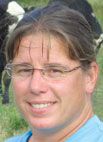
“He’s got about 10 years on me,” chuckled Lydia Ernszt, talking about her husband Andy and the years experience with cattle. “We’ve been working these cattle together on this farm since 2001,” she said.
Andy and Lydia Ernszt own and operate ALE Ranch Limousin in Texas County, near Summersville, Mo. “This is a family farm with our sons, Cody, 18 and Brandon, 16 and ourselves.
“We were living in Huggins, Mo., and I worked in bridge construction,” Lydia explained. “It was getting more dangerous to work on that type of construction and as the only female, I knew I needed a change.”
So she came home and asked Andy what they could do so she could quit that type of work. “His answer was to sell the place we were at and get a bigger farm where we could run more cattle,” she said.
The Purebred Purchase
The Ernszts bought the farm they are currently at in 2001. “That is about the time we bought our first Limousin cattle too,” she said. “We always drove by this nice herd of cattle that we admired. When we were looking to increase our herd size, we responded to an ad and realized they were the cattle we had been admiring.
“Our first Limousin cattle consisted of 15 head of bred cows,” she explained. “We kept heifers from these cows and some bulls for a couple of years to increase our Limousin herd and we used Limousin bulls on our commercial cattle.”
Over the years, on the farm in Summersville, consisting of just over 800 acres, the Ernszt family continued to increase their herd size. “Just this past year we sat down and looked at things and with Cody, headed off to college this fall, we realized we had more than we could handle come winter time. We had about 300 head of commercial and purebred animals,” explained Lydia.
“So we began to cut back our commercial herd and are now down to about 210 momma cows. We are working towards a purebred herd and right now we have about 150 Limousin,” she said. “We still have some commercial cows to help pay the bills.”
Why Limousin
“When we went to look at this herd, we were impressed with how they were maintained and their disposition,” she said. “We did some research to learn more about the breed and liked the fact they are fairly easy to raise, don’t have many feet problems and in the end give us more pounds of calf on the ground at sale time.
“They have gone above and beyond our expectations and we have fallen in love with the Limousin breed,” she added. “Limousin cattle come from France and the first one in North America was in Canada in 1968. They weren’t imported into the United States until 1971 when a group of Kansas Limousin breeders brought one to Topeka, Kan.,” she explained.
Over time they have proven to have qualities that are good for cattlemen. “They produce good meat, have good maternal instincts and work well on our farm,” she added. “They grow well and we like that you can choose from higher marbling EPD bulls or use a lower marbling EPD bull to produce leaner meat, based on your cow herd and their EPDs.”
ALE Ranch keeps records on their purebred herd and have their animals DNA tested through Igenity. “We send them the hair and blood samples and we receive DNA data on the herd. This allows us to compare DNA with EPDs and get a better idea of what type of animal they will produce,” she explained.
The Future
“I will be taking an AI course in October and this will allow us to bring in different genetics,” Lydia explained. “As purebred breeders, you can’t have all the bulls to match all your cows. So we’ll be able to use AI.”
In addition to the purebred herd they are working towards, the Ernszts also utilize rotational grazing and put up all their own hay. “Between all the things we do on our farm, we stay busy,” explained Lydia. “But we’ve also been working on this for a while and have a pretty good schedule down.
“We utilize rotational grazing to help our pasture land stay fertile,” she explained. “This also keeps our cattle calmer because we are around them more than many and they are always ready to be moved,” she added.
The future looks bright for ALE Ranch Limousin. “We’d like to be able to sell registered cattle off our farm and hold our own production sale as early as next year,” she explained.
She advised commercial producers: “A bull is half of your genetics, so don’t skimp in this area. Many times if you pay more for the quality in the beginning you will net more and be better off in the end.”







